Varieties of sundew and its cultivation
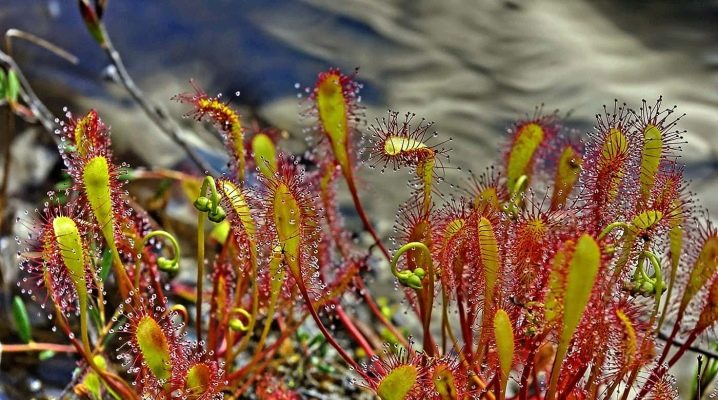
The sundew is one of the brightest representatives of marsh carnivorous plants. However, this flower does not only grow in the wild. It can be grown at home, but such an occupation can hardly be called ordinary. In this article, we will tell you more about the sundew, consider its most popular varieties that are suitable for indoor cultivation, and also figure out how to care for this predatory plant.
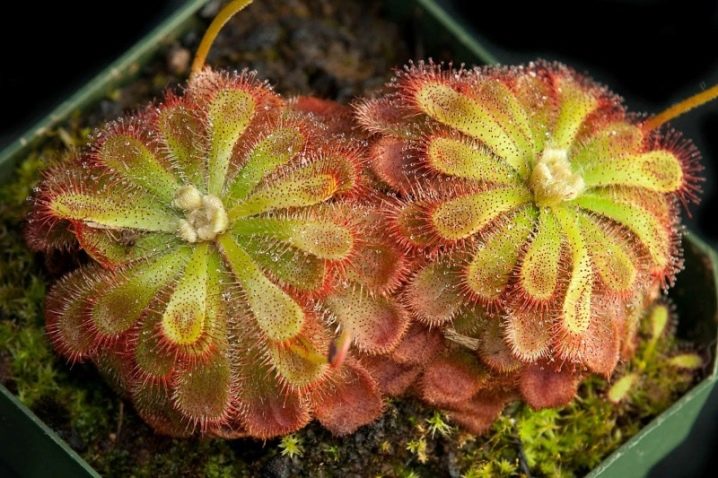
general description
The sundew, also known as the flycatcher, is a flower that feeds on insects. It is a carnivorous plant belonging to the sundew family. It lives in swampy areas, sandstones and mountains. You can meet him on almost any kind of soil. Note that this predator can also be raised at home, which is often practiced in Russia.
Dewdrop is rightfully considered perennial plant, after all, the duration of her life can be from two to 10 years. Its flowering, as a rule, falls in the spring or summer period: it is at this time that the central leaves of the predatory flower form stalks and flowers of light shades, which are collected in spikelets. But the fruits begin to form by the end of summer and look like boxes with small seeds.
It is also interesting that during flowering the flycatcher is safer for insects. This is explained by the fact that during this period there are no special sticky droplets on its flowers and peduncles, due to which insects have the opportunity to pollinate the plant.
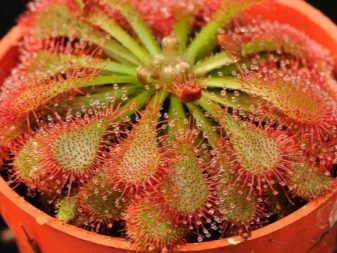
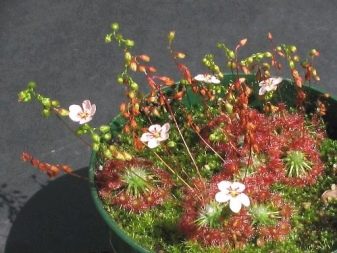
It is worth mentioning the nutrition of the sundew. Her diet includes not only insects, although many people mistakenly think so. In their absence, the flycatcher is able to eat like the most ordinary plant. But in order to feed on insects, the sundew needs to attract them. She does this with the help of shiny droplets that look like dew drops. They are sticky and are a digestive enzyme. It is due to these drops that the victim of the flower sticks to the leaves.
Further, the cilium on which the insect sits is bent to the center of the leaf along with other cilia. In the process, the plant strangles the insect, and the leaf gradually begins to close. It is interesting that such a process can be seen only in those cases when protein food has got on the leaf. The sundew will not react to other substances in any way.
Further, the insect is digested, during which a special substance resembling pepsin is released. This is what helps break down protein. In the end, the leaf begins to open, after which it is often possible to notice the chitinous cover of the insect on it, the cilia themselves become straight, begin to become covered with sticky droplets and again beckon "lunch".
Note that the process of digestion of food in a sundew is not as fast as it might seem at first glance. In fact, it can take more than one day.
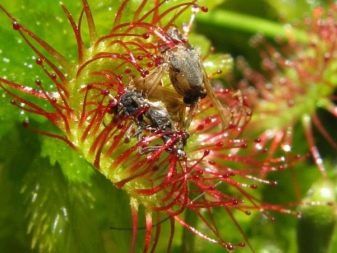
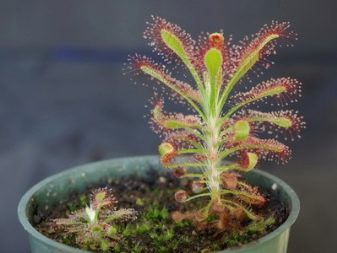
Types and varieties
There are many types and varieties of sundew, among them "Alba", "Alicia", "Paradox", "Spatulata", "Intermediate", "English" and many others. Consider those varieties that are most suitable for indoor growing.
So, the most common type of flycatcher is round-leaved sundew... It is very resistant to winter and can often be found in peat bogs.
If you plan to grow a wild specimen of this plant in a pot, then in this case, you will definitely need to add the soil in which the flycatcher previously grew to the pot.
This sundew is distinguished by the presence of round leaves, which are located next to the root zone. On them you can see red cilia that give off sticky dew.
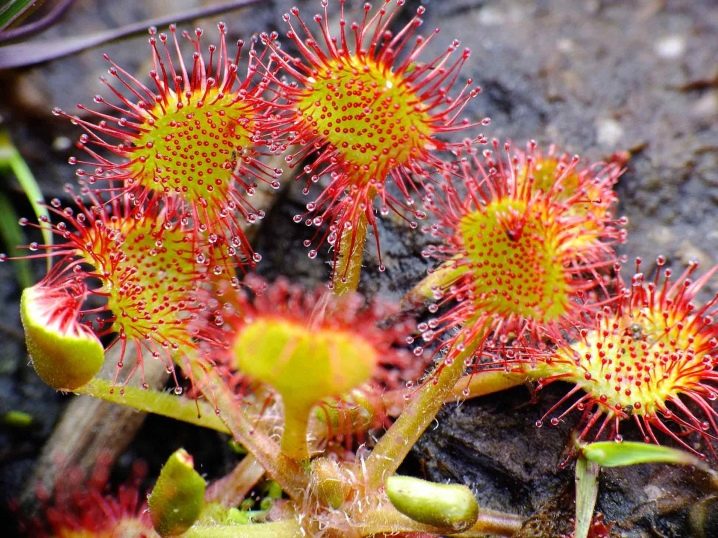
The Cape sundew is also distinguished, which is distinguished by its beauty and unpretentiousness. This predator grows all year round and easily adapts to new conditions. In height, the flower, as a rule, does not exceed 12 centimeters. It differs from other varieties by the presence of elongated leaves that have a light green or reddish tint.
The English sundew is also widespread, which is often found in the territories of Ukraine, Russia, Belarus and not only. It grows mainly in damp and sandy areas, as well as in sphagnum bogs. The height of the flower, as a rule, varies in the region of 7-25 centimeters. It blooms at the very height of summer. During this period, the plant has white flowers.
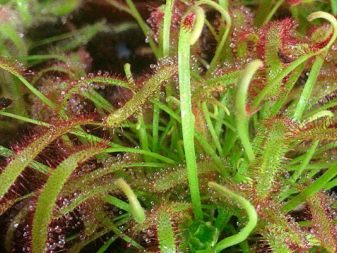

Landing
The sundew is a rather unpretentious predator. Taking care of her is not so difficult even for beginners.... However, in order to grow a full-fledged and beautiful flower, you still need to take care of providing favorable conditions for it.
So, the first thing you need to pay attention to is the landing. For planting a sundew, it is best to use a glass container or a semi-automatic aquarium. This will provide the flower with the necessary moisture level and eliminate the possibility of problems due to a changed environment. When the root system of a predatory flower develops, and the bowl becomes small for him, it will need to be transplanted. This is usually done in late winter - early spring.
Particular attention should be paid to the selection of soil for planting sundew. As a rule, many people recommend choosing peat moss for this. It needs to be cleaned well before use to eliminate the possibility of mold formation. However, moss can be replaced. This is perfect for this coconut fiber or, for example, aquatic plant soil.
Do not forget about lighting, because the sundew does not like the shadow. Artificial light will definitely not be enough for her, but you can use it as a supplement, it will not be superfluous.
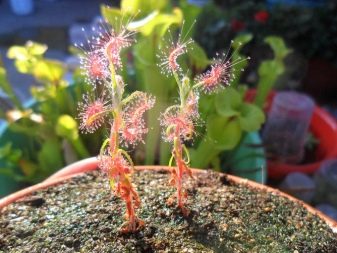
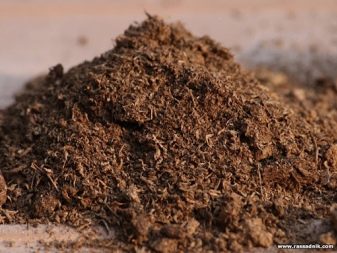
Care
Watering
Water is important for a flycatcher, as for any other plant, but a sundew may not tolerate drought. For this reason, the moss and soil must be moisturized on a permanent basis. It is recommended to water the flower using a pallet: it is into it that you need to pour water, which after a while will need to be drained. In addition to watering, spraying of the soil is also necessary, which will help prevent the top layers from drying out.
If we talk about the frequency of watering, then in warm weather they must be carried out at intervals of three days. In winter, this interval extends to a week.
If you live in an area characterized by a high level of humidity and temperature, then in this case, you can raise a predator outside. But do not forget about draining excess water from the pot, otherwise there is a risk of root rot.
Separately, we note that it is recommended to use rain or distilled water for watering the sundew. It is she who will help to achieve acidic soil, which will contain a minimum amount of minerals - it is this soil that is most favorable for this flower.

Top dressing
But the sundew does not need feeding, which noticeably distinguishes it from many cultivated plants. However, you can purchase insects for the flower - you can do this at a regular pet supply store. As a rule, a couple of flies per week are enough for one plant. In winter, the sundew should be fed once a month, since during this period the flower begins to slow down in growth, but does not die.
In the summertime, the sundew is allowed to be put out on the street. There she will catch food for herself on her own.
Separately, we note that it is not worth feeding the plant with large insects, as they can damage the leaf.
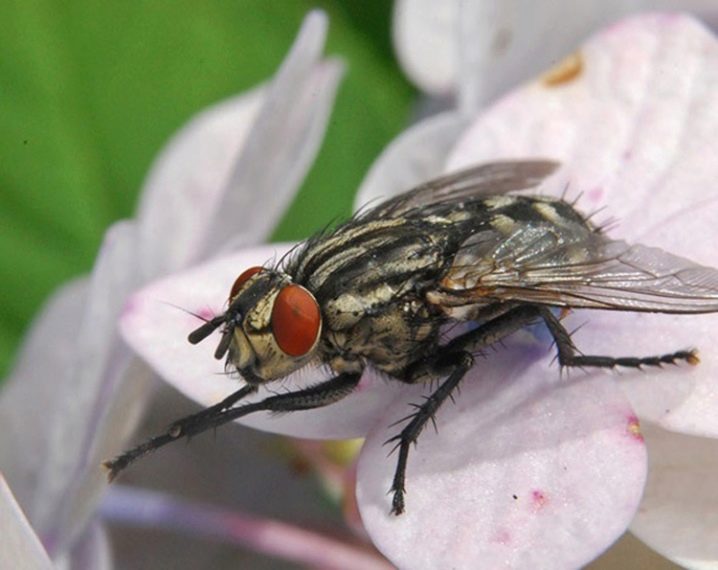
Transfer
Transplanting a sundew is carried out only in those cases when the growing bowl becomes small. As a rule, a predatory flower is transplanted in February or March in order to be in time before the plant awakens.
It is recommended to grow a sundew in wide and low containers that have drainage holes.

Reproduction
Dewdrop reproduces by cuttings, dividing the bush and seeds.
- Cutting involves cutting a leaf from a mother flower. This leaf must be kept in a moist sphagnum, in a greenhouse. Small shoots appear after two months, after which the plant is planted in a bowl.
- To grow a sundew from seeds they must be poured onto a peat mixture mixed with sand and sprayed. Next, the seeds need to be covered with glass or foil. For several weeks they need to be kept in high-quality lighting conditions and at a temperature of at least +25 degrees. When the first few leaves appear, the plant must be pricked.
- Sundew propagation by dividing the bush happens as follows: the rosette, which moves to the side, must be separated from the mother liquor and planted in another container.
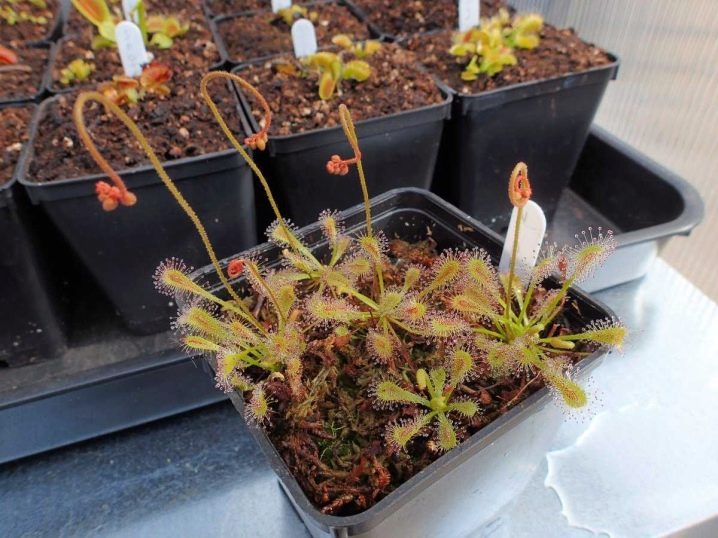
Diseases and pests
Parasitic insects rarely infect sundew for obvious reasons, however, problems with them can still arise, and the cause of their occurrence, as a rule, is a spider mite or aphid. These pests can cause huge damage to the flower, because of which it will begin to deform and noticeably slow down its growth.
To get rid of parasites, we recommend using a chemical agent such as Actellik. You can find out about the rules for its use from the instructions on the package of the drug.
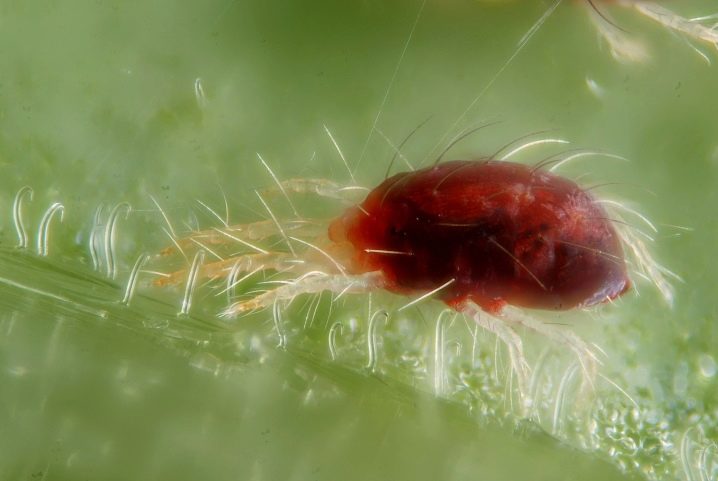
But various kinds of diseases often attack the flycatcher, however, they usually arise due to mistakes in care.
- Most often, the sundew is affected by gray rot. When it occurs, the diseased parts of the flower are eliminated, and all the rest are sprayed with fungicides.
- But in conditions of low temperatures and high moisture, it can begin to develop root rot... You can find out about its occurrence by the blackened leaves and stem parts, as well as by stalled growth. In this case, the rotten roots will have to be removed. In this case, the flower should be transplanted into new soil and another container, having previously disinfected them.
- If the flower does not have enough moisture or the soil does not suit it, then its leaves do not form sticky dew droplets, which is also a problem... If this happens, then it is recommended to change the soil and increase watering frequency.
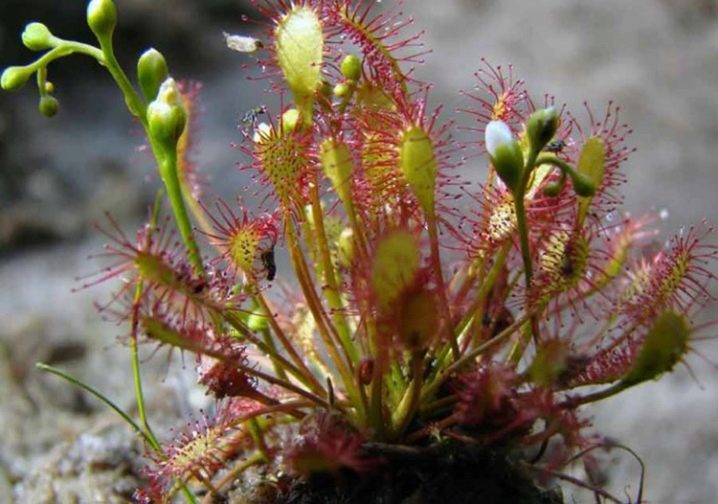

























The comment was sent successfully.